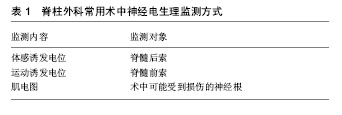| [1] 朱士广,杨树源. 脊髓手术中的神经电生理监测[J]. 临床神经电生理学杂志,2006,15(2):99-102.[2] Holdefer RN, MacDonald DB, Skinner SA. Somatosensory and motor evoked potentials as biomarkers for post-operative neurological status.Clin Neurophysiol. 2015;126:857-865. [3] 林国中,王振宇. 神经电生理监测在脊髓手术中的应用[J]. 临床神经外科杂志,2012,9(2):117-119.[4] Thirumala PD, Huang J, Thiagarajan K, et al. Diagnostic accuracy of combined multimodality somatosensory evoked potential and transcranial motor evoked potential intraoperative monitoring in patients with idiopathic scoliosis. Spine. 2016;41(19):E1177-1184.[5] 张玉新,何帆,王珏.多模式神经电生理监测在脊柱手术中报警因素分析[J].现代电生理学杂志,2014,21(4):199-203.[6] Rabai F, Sessions R, Seubert CN. Neurophysiological monitoring and spinal cord integrity. Best Pract Res Clin Anesthesiol. 2016; 30(1):53-68.[7] Roy MW, Gilmore R, Walsh JW. Evaluation of children and young adults with tethered spinal cord syndrome. Utility of spinal and scalp recorded somatosensory evoked potentials. Surg Neurol. 1986;26(3):241-248.[8] Devlin VJ, Anderson PA, Schwartz DM, et al. Intraoperative neurophysiologic monitoring: focus on cervical myelopathy and related issues. Spine J. 2006; 6(6):S212-S224.[9] Nuwer MR, Dawson EG, Carlson LG, et al. Somatosensory evoked potential spinal cord monitoringreduces neurologic deficits after scoliosis surgery: results of alarge multicenter survey. Electroencephalogr Clin Neurophysiol.1995;96(1):6-11.[10] Ginsburg HH, Shetter AG, Raudzens PA. Postoperative paraplegia with preserved intraoperative somatosensory evoked potentials. J Neurosurg.1985;63(2):296-300. [11] Guerit JM. Neuromonitoring in the operation room: why, when and how to monitor . Electrocephalogr Clin Neurophysiol.1998;106(1): 1-21.[12] Storm SA, Kraft GH. The clinical use of dermatomal somatosensory evoked potentials in lumbosacral spinal stenosis. PhysMed Rehabil Clin N Am. 2004;15(4): 107-115.[13] Langeloo DD, Lelivelt A, Louis JH, et al. Transcranial electrical motor-evoked potential monitoring during surgery for spinal deformity: a study of 145 patients. Spine. 2003;28(10):1043-1050.[14] 庄乾宇,王树杰,仉建国,等.经颅电刺激运动诱发电位监测标准化方案在1543例脊柱畸形矫形手术中的应用[J].中华骨与关节外科杂志, 2015,8(1):27-31.[15] Reitsma JB, Glas AS, Rutjes AW, et al. Bivariate analysis of sensitivity and specificity produces informative summary measures in diagnostic reviews. J Clin Epidemiol. 2005;58(10): 982-990.[16] 邱勇,刘兴勇.神经电生理监测在脊柱外科的应用现状[J].中国脊柱脊髓杂志,2015,25(7):670-672.[17] 谭海涛,江建中,谢兆林,等.肌电图监测在极外侧入路椎间融合术联合经皮椎弓根螺钉内固定术中的应用[J].中国脊柱脊髓杂志,2015, 25(7):618-624.[18] Haghighi SS, Blaskiewicz DJ, Ramirez B, et al. Can intraoperative neurophysiologic monitoring during cervical spine decompression predict post-operative segmental C5 palsy? J Spine Surg. 2016; 2(3):167-172.[19] Kimura J. Peripheral Nerve Diseases. Amsterdam: Elsevier, 2006: 621-630.[20] Holland NR. Intraoperative electromyography. J Clin Neurophysiol. 2002;19(5):444-453.[21] 胡楷,熊梅,王言,等.神经电生理监测在经皮内窥镜下腰椎间盘切除术中的应用[J].中国脊柱脊髓杂志,2015,25(7):602-606.[22] Tamkus AA, Rice KS, Kim HL. Differential rates of false-positive findings in transcranial electric motor evoked potential monitoring when using inhalational anesthesia versus total intravenous anesthesia during spine surgeries. Spine J. 2014; 14(8): 1440-1446.[23] 陈炎春,卫法泉,孔飞娟.脊柱侧弯矫形术中七氟烷联合丙泊酚静吸复合麻醉对SEP及MEP的影响[J].中华全科医学, 2017,15(3): 418-420+527.[24] 汪露,角述兰,杨娟,等.地氟醚和七氟醚对术中运动诱发电位监测的影响[J].临床麻醉学杂志,2015,31(3):253-256.[25] Kopp LA, Yost CS, Kindler CH. Anaesthetic mechanisms: update on the challenge of unravelling the mystery of anaesthesia. Eur J Anaesthesiol. 2009;26(10):807-820.[26] Campagna JA, Miller KW, Forman SA. Mechanisms of actions of inhaled anesthetics. N Engl J Med. 2003; 348(21):909-910. [27] Bonhomme V, Boveroux P, Hans P, et al. Influence of anesthesia on cerebral blood flow, cerebral metabolic rate, and brain functional connectivity. Curr Opin Anaesthesiol. 2011;24(5): 474-479.[28] Li Y, Meng L, Peng Y, et al. Effects of Dexmedetomidine on motor- and somatosensory-evoked potentials in patients with thoracic spinal cord tumor: a randomized controlled trial. Bmc Anesthesiol. 2015;16(1):51-58.[29] 张园园,董江涛,代志刚,等.不同剂量顺式阿曲库铵对神经外科手术运动诱发电位的影响[J].临床麻醉学杂志, 2017,33(2):129-132.[30] Zhuang Q, Wang S, Zhang J, et al. How to make the best use of intraoperative motor evoked potential monitoring? experience in 1162 consecutive spinal deformity surgical procedures. Spine. 2014;39(24):1425-1432.[31] 戴景兴,原林,周志涛,等.结扎数支肋间后动脉对胸腰段脊髓血供影响[J].中国临床解剖学杂志,2003,21(6):575-577.[32] 曲瑶, 于高起, 韩伟,等. 低体温对患者体感诱发电位的影响[J]. 中华麻醉学杂志, 2011, 31(1):13-16.[33] Kottenberg-Assenmacher E, Armbruster W, Bornfeld N, et al. Hypothermia does not alter somatosensory evoked potential amplitude and global cerebral oxygen extraction during marked sodium nitroprusside-induced arterial hypotension. Anesthesiology. 2003; 98(5):1112-1118.[34] 陈裕光,万勇,郑召民,等.脊柱侧凸手术中TES-MEP、CSEP阳性与手术操作相关原因分析[J].脊柱外科杂志,2010,8(2):86-89.[35] Noonan KJ, Walker T, Feinberg JR, et al. Factors related to false- versus true-positive neuromonitoring changes in adolescent idiopathic scoliosis surgery. Spine. 2002;27(8):825-830.[36] Dawson EG, Sherman JE, Kanim LE, et al. Spinal cord monitoring. results of the scoliosis research society and the european spinal deformity society survey. Spine(Phila Pa 1976).1991;16:S361-364.[37] Neurophysiological Monitoring of Spinal Cord Function During Spinal Deformity Surgery. in: Scoliosis Research Society, 2009.[38] Nuwer MR. PW6-1 IONM techniques useful in assessing spinal cord function in scoliosis surgery. Clin Neurophysiol. 2010;121 (10):S89-S89.[39] Schwartz DM, Auerbach JD, Dormans JP, et al. Neurophysiological detection of impending spinal cord injury during scoliosis surgery. J Bone Joint Surg Am. 2007;89(11): 2440-2449.[40] Tamaki T, Kubota S. History of the development of intraoperative spinal cord monitoring. Eur Spine J. 2007;16(2):140-146.[41] Hickey R, Albin MS, Bunegin L, et al. Autoregulation of spinal cord blood flow: is the cord a microcosm of the brain? Stroke. 1986; 17(6): 1183-1189.[42] Gonzalez AA, Jeyanandarajan D, Hansen C, et al. Intraoperative neurophysiological monitoring during spine surgery: a review. Neurosurg Focus. 2009;27(4):E6.[43] Sutter M, Eggspuehler A, Muller A, et al. Multimodal intraoperative monitoring: an overview and proposal of methodology based on 1017 cases. Eur Spine J. 2007; 16(Suppl 2): S153-S161.[44] Sloan TB, Mongan P, Lyda C, et al. Lidocaine infusion adjunct to total intravenous anesthesia reduces the total dose of propofol during intraoperative neurophysiological monitoring. J Clin Monit Comput. 2014;28(2):139-147.[45] Jou IM, Chern TC, Chen TY, et al. Effects of desflurane on spinal somatosensory-evoked potentials and conductive spinal cord evoked potential. Spine. 2003;28(16):1845-1850.[46] Hasan MS, Tan JK, Chan CYW, et al. Comparison between effect of desflurane/remifentanil and propofol/remifentanil anesthesia on somatosensory evoked potential monitoring during scoliosis surgery—A randomized controlled trial. J Orthop Surg. 2018; 26(3):1-7.[47] 严彬,黄晓虹,吴元珏,等.右美托咪定对颈椎前路手术运动诱发电位监测的影响[J].实用骨科杂志,2018,24(3):223-225.[48] Kuizenga K, Wierda JM, Kalkman CJ. Biphasic EEG changes in relation to loss of consciousness during induction with thiopental, propofol, etomidate, midazolam or sevoflurane. Br J Anaesthesia. 2001; 86(3):354-360.[49] 于琳琳,王军,马越,等.不同肌松水平对术中脊髓神经电生理监测的影响[J].首都医科大学学报,2017,38(3):357-360.[50] 李传翔,宋伏虎,王怡,等.不同肌松程度对脊柱外科手术经颅电刺激运动诱发电位监测的临床观察[J].南方医科大学学报,2010,30(12): 2686-2688.[51] 孙麟,罗超,宋跃明,等.重度脊柱侧弯患者术中血压变化对体感诱发电位的影响及处理方法[J].华西医学,2014,29(1):19-22.[52] 齐宗华,西永明,刘勇,等.颈胸椎手术中体感诱发电位监护的影响因素分析及准确性观察[J].中华外科杂志,2007,45(4):240-242. |
.jpg)


.jpg)
.jpg)